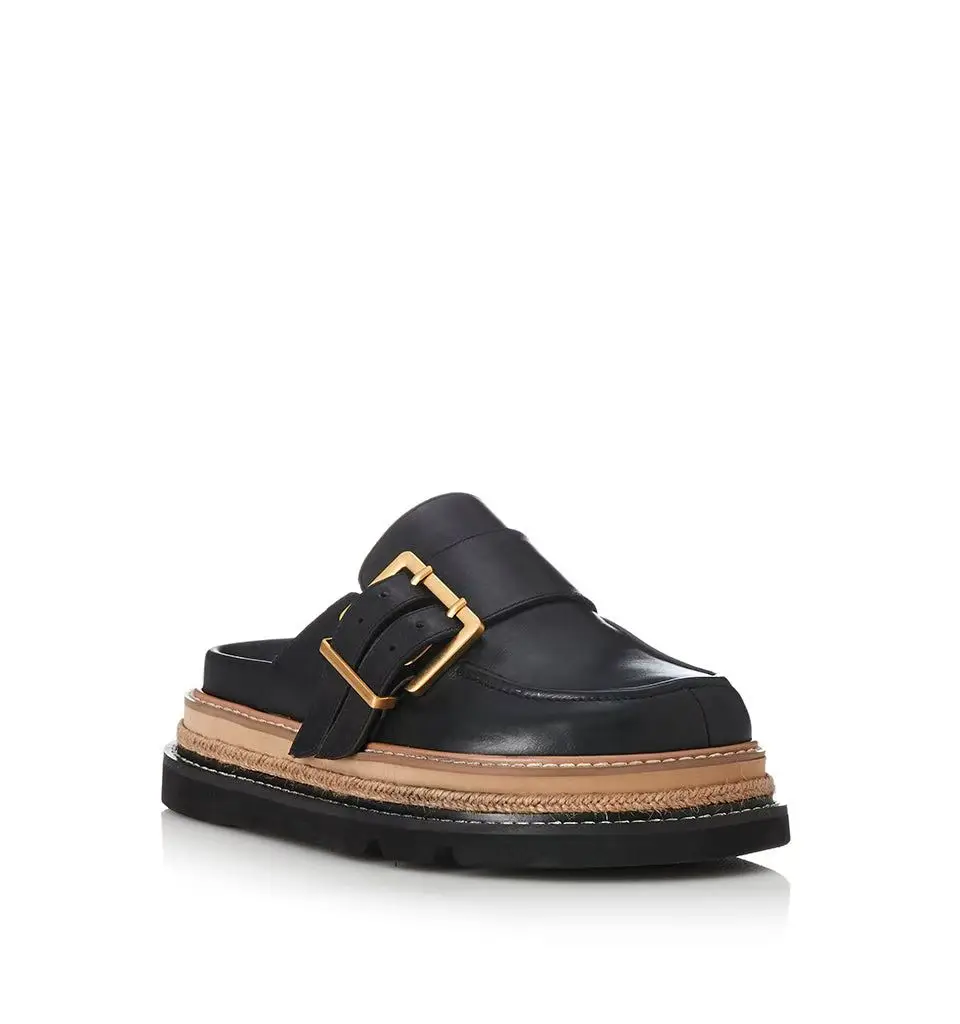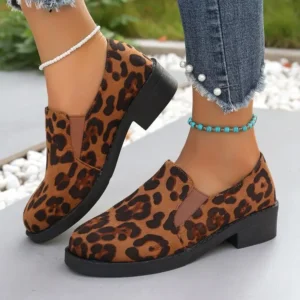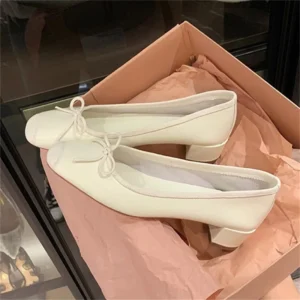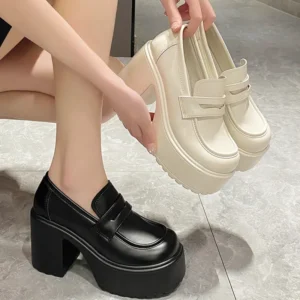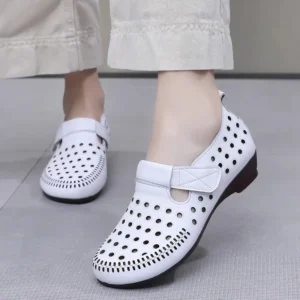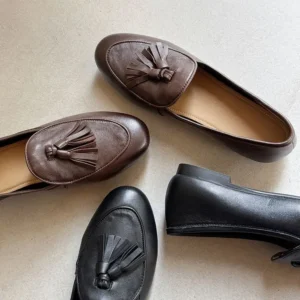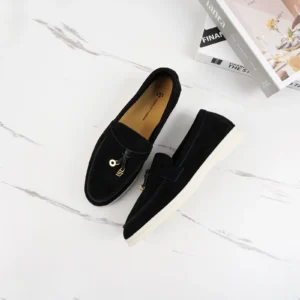1. Why Your Loafer Material Matters: An Introduction
When shopping for the perfect pair of loafers, most people focus on style and price, but the material of your loafers deserves equal consideration. The fabric or substance used in crafting your loafers dramatically impacts their comfort, how long they’ll last, what occasions they suit, and even how they make you feel when wearing them.
Material selection is the foundation of a satisfying loafer experience. It determines whether your feet will breathe comfortably during summer outings or stay protected during cooler seasons. It affects how the loafers mold to your feet over time and whether they’ll maintain their appearance after regular wear.
Making an informed choice about loafer materials ensures both immediate satisfaction and long-term value. Consider these key impacts:
- Comfort level: Different materials offer varying degrees of softness, flexibility, and breathability
- Durability: Quality materials can extend the lifespan of loafers by years
- Style versatility: Some materials transition seamlessly from casual to formal settings
- Maintenance requirements: Care needs range from simple wipe-downs to specialized treatments
At Artisan Haul, we carefully evaluate every material aspect when curating our women’s loafer collection. Our specialists examine the grain quality of leather, the density of suede, and the construction of synthetic options to ensure exceptional performance.
Understanding the fundamentals of leather vs. suede loafer care makes a significant difference in your satisfaction with whichever pair you choose. Let’s explore the full range of material options to help you make the best decision.
2. Classic Loafer Materials: Traditional Options Compared
2.1. Full-Grain Leather: The Gold Standard
Full-grain leather represents the highest quality leather available for loafers. Unlike other leather types, it includes the entire top layer of the hide with all its natural grain intact. This premium material maintains the hide’s original texture and markings, creating a unique character in each pair.
What makes full-grain leather exceptional is its remarkable durability combined with the ability to develop a beautiful patina over time. Rather than deteriorating, this material actually improves in appearance as you wear it, developing a rich, personalized finish that reflects your unique wearing patterns.
Pros:
– Exceptional durability (can last 10+ years with proper care)
– Develops distinctive patina with age
– Excellent breathability
– Molds to your foot for customized comfort
– Maintains structure and shape over years of wear
Cons:
– Higher initial investment ($150-400 for quality pairs)
– Requires regular conditioning and maintenance
– May have longer break-in period
– Not naturally water-resistant without treatment
Full-grain leather loafers provide versatility that few other materials can match. They can be polished to a refined finish for formal settings or maintained with a more relaxed look for business casual environments. Understanding proper leather vs. suede maintenance guide techniques ensures you’ll get the maximum lifespan from this premium material.
2.2. Suede: Sophisticated Yet Delicate
Suede comes from the underside of animal hides, typically from split leather that’s been buffed to create a soft, napped finish. This distinctive process gives suede its characteristic velvety texture that instantly adds sophistication to any loafer design.
What makes suede special is its understated elegance. The textured, non-reflective surface creates visual depth and richness that smooth leathers can’t replicate. This material excels in casual to business-casual settings and particularly shines during fall and spring seasons.
Pros:
– Luxurious, soft texture
– Unique visual appeal and depth
– Comfortable from first wear (minimal break-in)
– Available in rich, vibrant colors
– Excellent for adding texture to an outfit
Cons:
– Requires special care and protection products
– Vulnerable to water stains and dirt
– Not ideal for wet weather
– Shows wear patterns more visibly
– Requires regular brushing to maintain appearance
Many people mistakenly believe suede is too delicate for regular wear. However, with proper preventative care and periodic cleaning, suede loafers can remain beautiful for years. Investing in quality suede protector spray and a good suede brush makes maintenance straightforward. For specific maintenance techniques, our care guide for suede loafers provides comprehensive instructions.
2.3. Patent Leather: Formal Elegance
Patent leather is distinguished by its high-gloss, mirror-like finish that instantly elevates any loafer to formal status. Created by applying a special coating to regular leather, this material develops a hard, shiny surface that’s instantly recognizable.
The striking glossiness of patent leather makes it the perfect choice for black-tie events, formal dinners, and special occasions. Its reflective surface catches light beautifully and pairs perfectly with formal attire, adding a sophisticated finishing touch to dressy outfits.
Pros:
– Unmistakable formal appearance
– Highly water-resistant
– Easy to clean (typically requires just wiping)
– Resistant to stains
– Makes a bold style statement
Cons:
– Limited breathability
– Prone to creasing and cracking over time
– Not ideal for extended wear or walking
– Less versatile than other leather types
– Can feel stiff compared to softer leathers
For maintaining patent leather’s lustrous finish, avoid harsh cleaners and instead use a soft cloth with specialized patent leather cleaner or simply warm water. Store patent loafers with shoe trees to help prevent creasing, and keep them away from extreme temperatures that can damage the coating.
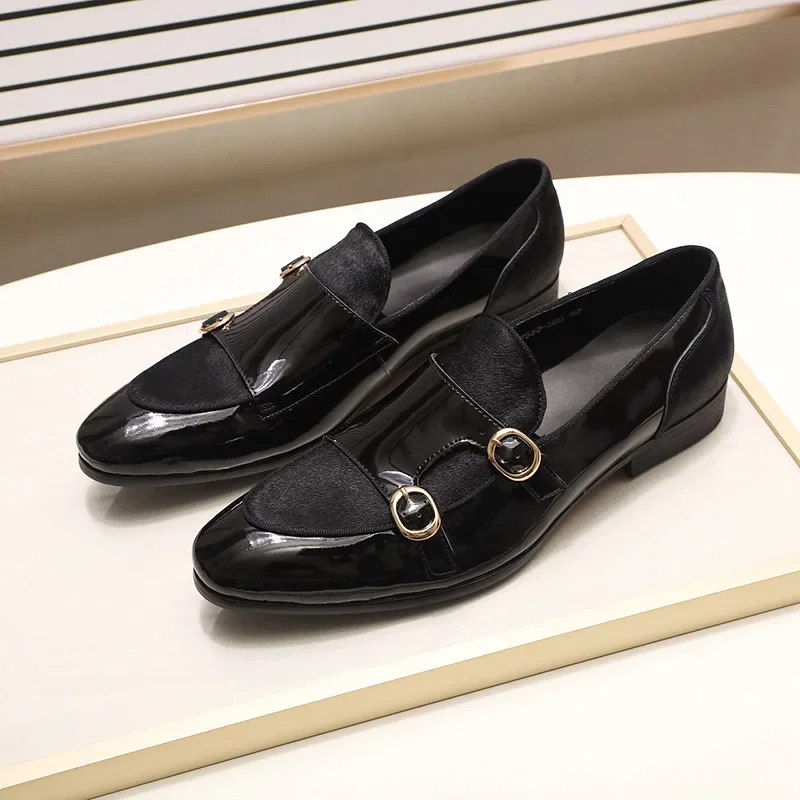
Our collection of women’s leather flat loafers includes several patent leather options perfect for formal occasions.
2.4. Canvas and Textiles: Casual Comfort
Canvas and textile loafers bring casual breathability to the classic loafer silhouette. These materials, derived from cotton, linen, hemp, and synthetic fibers, create lightweight footwear perfect for warmer seasons and relaxed settings.
The primary appeal of textile loafers is their comfort and casual versatility. These materials conform quickly to your foot shape without requiring a break-in period. They’re also typically more affordable than leather options, making them excellent entry-level choices or alternatives for casual summer wear.
Textile Variations:
– Cotton canvas: Durable, breathable, and easy to clean
– Linen: Ultra-lightweight with excellent cooling properties
– Denim: Casual with unique fading patterns over time
– Woven textiles: Interesting textures and pattern possibilities
– Cotton blends: Balance of comfort and durability
Canvas and textile loafers typically range from $40-120, significantly more affordable than premium leather options. They work perfectly for casual weekend outings, beach vacations, and relaxed office environments where comfort is prioritized.
For the best selection of versatile styles, our women’s flat classic loafers collection includes numerous textile options ideal for casual wear.
3. Modern Synthetic Materials: Innovation in Loafer Design
3.1. Faux Leather: Vegan-Friendly Alternatives
Faux leather offers an animal-free alternative to traditional leather with continuously improving quality and appearance. These synthetic materials—primarily polyurethane (PU) and polyvinyl chloride (PVC)—replicate the look of genuine leather while offering different performance characteristics.
Today’s premium synthetic leathers can be surprisingly convincing, with realistic grains, proper weight, and improved durability compared to earlier generations. High-quality versions incorporate micro-perforations for breathability and backing materials that enhance comfort and longevity.
When comparing synthetic options:
- Polyurethane (PU) leather: Generally more flexible, breathable, and environmentally preferable
- PVC leather: Typically more water-resistant but less breathable and less eco-friendly
- Bio-based synthetics: Newer options incorporating plant materials for improved sustainability
- Microfiber synthetic: Ultra-fine fibers create a soft, suede-like option with better durability
Quality faux leather loafers typically cost between $50-150, making them more accessible than genuine leather while still offering good performance. They excel in situations where you need water resistance, minimal maintenance, and ethical material sourcing.
To ensure you’re getting quality synthetic materials, look for even coloration, reinforced stitching, and backing materials that enhance durability. For comparison purposes, our ultimate guide to pristine leather loafers helps highlight the differences between genuine and synthetic options.
3.2. Performance Synthetics: Beyond Basic Faux Leather
Performance synthetics represent the cutting edge of footwear material technology, going far beyond simply mimicking leather. These advanced materials are engineered specifically for enhanced functionality—incorporating features like moisture-wicking properties, temperature regulation, and remarkable flexibility.
Unlike basic faux leather, performance synthetics are often designed from the ground up for specific wear conditions. They may incorporate multiple layers, specialized weaves, or technical coatings that provide benefits traditional materials cannot match.
Some innovative performance features include:
- Moisture-wicking interior linings that draw perspiration away from feet
- Antimicrobial treatments to reduce odor development
- Four-way stretch capabilities for exceptional comfort
- Enhanced breathability through microporous structures
- Weather-resistant membranes that block water while allowing vapor escape
Premium footwear brands are increasingly incorporating these technical materials even in traditionally styled loafers. The result combines classic aesthetics with modern performance—ideal for travelers, commuters, and anyone prioritizing all-day comfort.
For a contrast in texture and appearance, our women’s suede flat loafers collection offers a natural material alternative that provides different benefits than technical synthetics.
4. Sustainable Loafer Materials: Eco-Friendly Options
4.1. Plant-Based Leather Alternatives
Plant-based leather alternatives represent an exciting frontier in sustainable footwear materials. These innovative options use natural resources to create leather-like materials with significantly reduced environmental impact compared to both animal leather and petroleum-based synthetics.
These materials combine natural fibers with binding agents to create flexible, durable surfaces that function similarly to traditional leather while aligning with eco-conscious values.
Popular Plant-Based Options:
- Apple leather: Created from apple industry waste products, offering a supple texture with good durability
- Cactus leather: Derived from nopal cactus leaves, requiring minimal water and no irrigation
- Pineapple leather (Piñatex): Made from pineapple leaf fibers, a agricultural waste product, creating a versatile material with good texture
- Mushroom leather: Grown from mycelium (mushroom roots), creating an incredibly sustainable and biodegradable option
- Cork: Harvested without harming trees, providing water-resistant and lightweight properties
These materials typically cost similar to mid-range leather ($100-200) but come with the added value of environmental responsibility. Most plant-based options require similar care to synthetic leathers—occasional cleaning with mild soap and water, plus protection from extreme temperature and direct sunlight.
While still evolving in durability compared to traditional leather, these materials improve with each generation and provide distinctive textures and appearances that appeal to fashion-forward consumers.
For those who prefer traditional materials, our women’s leather penny loafers showcase classic styling with proven durability.
4.2. Recycled and Upcycled Materials
Recycled and upcycled materials represent a creative approach to footwear sustainability by transforming waste into fashionable, functional loafers. These materials reduce landfill burden and decrease demand for virgin resources while often creating unique aesthetic qualities.
Innovative footwear brands are increasingly incorporating post-consumer waste into various loafer components:
- Uppers made from recycled plastic bottles transformed into durable polyester
- Insoles incorporating recycled foam from manufacturing waste
- Outsoles containing recycled rubber from automotive tires
- Lining materials created from recycled polyester or natural textile waste
- Reinforcements utilizing recycled packaging materials
The performance of these recycled materials can be excellent, often matching or exceeding virgin materials. For example, recycled PET (from plastic bottles) creates polyester fibers with impressive strength and moisture management, while recycled rubber provides outstanding grip and durability in outsoles.
When shopping for genuinely sustainable recycled options, look for specific information about recycled content percentages and third-party certifications like Global Recycled Standard (GRS) or Recycled Claim Standard (RCS).
Understanding how all-day walking comfort style loafers incorporate these sustainable materials can help you make better purchasing decisions aligned with both comfort needs and environmental values.
5. Critical Components: Sole Materials and Construction
5.1. Sole Material Options
The sole of a loafer profoundly affects its comfort, durability, and appropriate use cases—yet it’s often overlooked during the shopping process. Different sole materials provide distinct advantages worth considering alongside upper materials.
| Sole Material | Durability | Comfort | Formality | Weather Performance | Resolable |
|---|---|---|---|---|---|
| Leather | Medium | Medium | High | Poor | Yes |
| Rubber | High | High | Low-Medium | Good | Sometimes |
| Crepe | Medium | Very High | Low | Medium | Rarely |
| EVA | Medium | Very High | Low | Good | No |
| TPR | High | High | Medium | Good | No |
Leather soles provide the most formal appearance and develop a comfortable footprint over time, but they offer limited traction and require protection from extended moisture exposure. They’re the traditional choice for dressy loafers.
Rubber soles deliver excellent grip and water resistance while providing good shock absorption. Modern rubber formulations can be quite slim and refined, making them increasingly acceptable even in business settings.
Crepe rubber (with its distinctive textured appearance) offers exceptional cushioning but tends to show dirt and wear more quickly than other options. It’s ideal for casual styles prioritizing comfort.
EVA (ethylene vinyl acetate) creates ultra-lightweight, cushioned soles perfect for all-day wear but with limited longevity compared to denser materials.
TPR (thermoplastic rubber) balances durability and flexibility while remaining cost-effective, making it common in mid-range loafers.
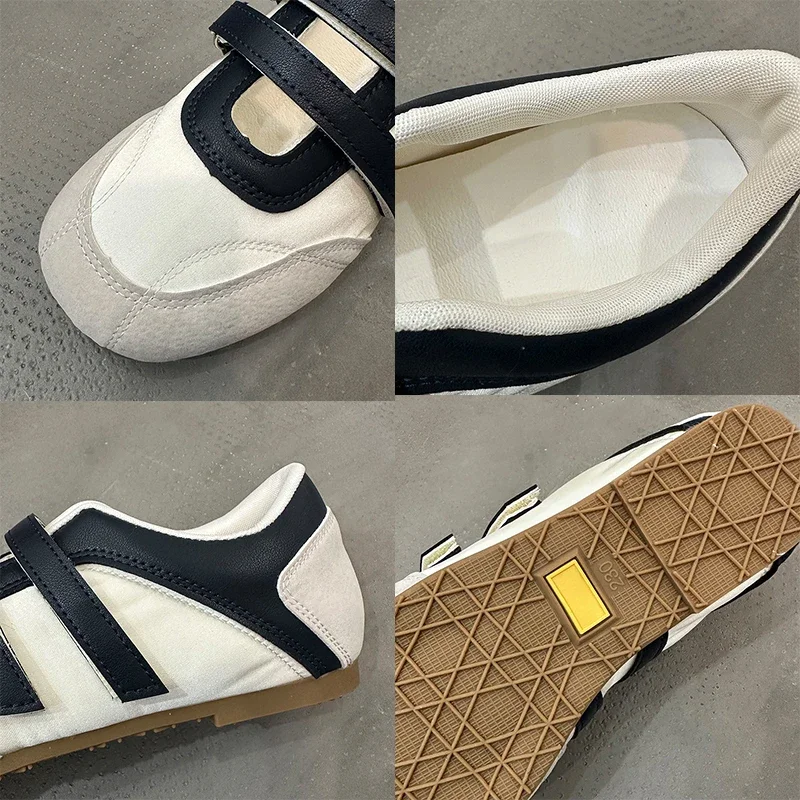
For loafers with substantial soles that provide additional height and support, our women’s platform chunky loafers collection offers stylish options with various sole constructions.
5.2. Interior Materials: Lining and Insoles
While exterior materials command most attention, interior components directly impact comfort during wear. Quality linings and insoles transform an attractive loafer into an all-day comfortable companion.
Loafer linings serve multiple purposes: they provide a smooth surface against your foot, enhance structural integrity, and manage moisture. The most common options include:
- Leather lining: Breathable, molds to foot shape, and provides temperature regulation
- Textile lining: Lightweight with good moisture absorption, ideal for warmer weather
- Synthetic lining: Often moisture-wicking with antimicrobial properties
- Unlined: Reduces weight and enhances flexibility but offers less structure
Insole construction is equally important for comfort. Quality insoles typically feature:
- Multiple density layers providing both cushioning and support
- Arch support contours that distribute weight properly
- Moisture-wicking top layers to keep feet dry
- Memory foam or gel inserts at high-pressure points
When examining potential loafers, feel inside for smooth seams and fully secured linings. Quality manufacturers ensure interior components match exterior materials in durability and performance. For wet weather concerns, understanding proper protecting suede loafers water techniques helps maintain both exterior and interior materials.
6. Material Selection Framework: Making the Right Choice
6.1. Lifestyle and Usage Considerations
Selecting the perfect loafer material starts with an honest assessment of your lifestyle and how you’ll primarily use the shoes. Different materials excel in different scenarios, and matching your choice to your needs ensures satisfaction.
For professional environments requiring polished appearances:
– Full-grain leather offers formal versatility with appropriate maintenance
– Patent leather provides maximum formality for special occasions
– High-quality synthetic leathers can work well in less conservative settings
For casual, everyday wear:
– Suede delivers sophisticated casual style with textural interest
– Canvas and textiles provide breathable comfort in warm conditions
– Performance synthetics offer practical durability for active lifestyles
Weather considerations should significantly impact material selection:
– Humid climates benefit from breathable natural materials like unlined leather
– Rainy regions require water-resistant options like treated leather or quality synthetics
– Varied climates might necessitate multiple loafer pairs for different seasons
If you travel frequently, consider:
– Versatile materials that transition between different settings
– Durable options that can withstand variable conditions
– Low-maintenance materials that don’t require special care while away from home
Understanding how leather loafers through seasons perform helps create a versatile footwear collection that serves you year-round.
6.2. Budget and Value Considerations
When investing in loafers, understanding the relationship between price, material quality, and long-term value helps you make smarter purchasing decisions. Different price tiers offer distinct advantages worth considering.
Entry-level ($40-80):
– Primarily synthetic materials and textiles
– Good for trying new styles or occasional wear
– Typically last 6-18 months with regular use
– Limited repairability when worn
Mid-range ($80-150):
– Better synthetic options or entry-level genuine leathers
– Improved construction methods and comfort features
– Can last 1-3 years with proper care
– Some may be repairable with basic services
Premium ($150-300):
– High-quality full-grain leather, premium suede, or advanced sustainable materials
– Superior construction with attention to detail
– Can last 5+ years with appropriate maintenance
– Often fully repairable, extending lifespan significantly
Luxury ($300+):
– Exceptional materials sourced from renowned tanneries
– Handcrafted construction techniques
– Potential lifespan of decades with proper care
– Full recraftability, including resoling and reconditioning
The concept of “cost-per-wear” helps evaluate true value. A $250 pair of well-made leather loafers worn 100 times yearly for five years ($0.50/wear) may actually cost less per use than an $80 pair that needs replacement after one year ($0.80/wear).
Where premium materials truly justify their cost:
– Footwear you wear multiple times weekly
– Professional settings where appearance impacts perception
– When comfort for long durations is essential
For those ready to invest in elevated style with lasting quality, our women’s leather heeled loafers collection offers sophisticated options crafted from premium materials.
7. Material Care Essentials: Maintaining Your Loafers
7.1. Care Techniques by Material
Proper material-specific care dramatically extends the lifespan of your loafers while maintaining their appearance. Each material has unique needs that are straightforward once understood.
Full-Grain Leather:
1. Clean surface dust with a soft brush or damp cloth
2. Apply quality leather conditioner every 1-3 months depending on wear
3. Use polish in matching color to restore appearance and provide protection
4. Allow 24-hour rest between wearings with cedar shoe trees inserted
5. Store in dust bags away from direct sunlight
Suede:
1. Brush with a dedicated suede brush after each wear to restore nap
2. Use specialized suede eraser for spot cleaning
3. Apply suede protector spray before first wear and quarterly thereafter
4. Avoid water exposure; if wet, stuff with paper and air dry slowly
5. Use shoe trees that don’t stretch the material
Patent Leather:
1. Wipe with a soft cloth after wearing to remove dust
2. Clean with a damp cloth and mild soap for stubborn spots
3. Apply patent-specific cream occasionally to prevent drying and cracking
4. Avoid alcohol-based products that can damage the finish
5. Store with tissue paper to prevent surfaces touching and sticking
Canvas/Textiles:
1. Brush away dry dirt with a soft brush
2. Spot clean with mild soap and water
3. For deeper cleaning, use gentle machine cycle in protective bag (if construction allows)
4. Air dry completely away from direct heat
5. Apply fabric protector for stain resistance
Synthetic Materials:
1. Wipe with damp cloth and mild soap as needed
2. Use baby wipes for quick refreshing
3. Apply synthetic-specific conditioner to prevent drying and cracking
4. Keep away from high heat sources that can warp materials
5. Use shoe trees to maintain shape
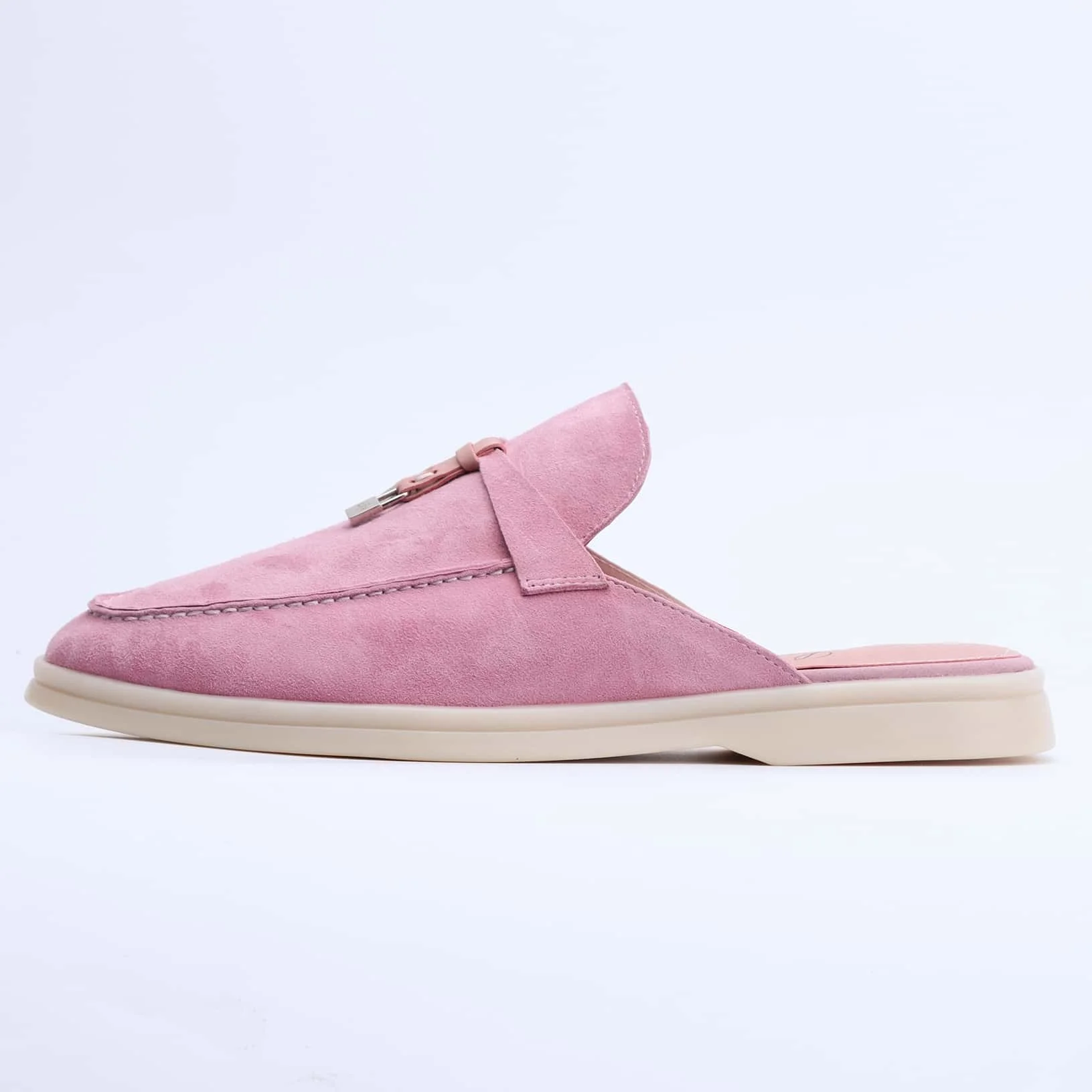
For specific product recommendations tailored to different materials, our guide on best products for loafer care provides trustworthy options for each care need.
7.2. Extending Loafer Lifespan Through Proper Care
Beyond material-specific techniques, several universal practices significantly extend the lifespan of any loafers, regardless of material:
- Rotate pairs regularly: Never wear the same loafers consecutive days—this allows moisture to fully evaporate and materials to recover their shape
- Use quality shoe trees: Cedar trees absorb moisture and maintain shape; unfinished cedar also helps deodorize
- Clean promptly: Address stains and dirt as soon as possible before they set permanently
- Protect before wearing: Apply appropriate protectants before the first wear, not after damage occurs
- Mind the weather: Check forecasts and avoid wearing vulnerable materials in adverse conditions
- Store properly: Keep in dust bags or boxes with appropriate support when not in regular rotation
- Repair early: Address loose stitching, heel wear, or sole issues before they worsen
- Professional cleaning: Schedule professional care for expensive pairs annually or when home care isn’t sufficient
Most loafers show early warning signs before serious damage occurs. Watch for:
– Excessive creasing or cracking in upper materials
– Worn areas on soles, especially at the heel and ball of foot
– Lining tears or excessive wear
– Diminished water resistance in treated materials
– Structural loosening around seams
For comprehensive guidance applicable to multiple materials, our complete guide to leather suede care provides detailed procedures for maintaining your finest footwear.
Women's Comfortable Flat Loafers, Women's Leopard Print Loafers, Women's Low Heel Loafers
$82.50 Select options This product has multiple variants. The options may be chosen on the product pageWomen's Block Heel Loafers, Women's Square Heel Loafers, Women's Square Toe Flat Loafers
Price range: $73.61 through $86.41 Select options This product has multiple variants. The options may be chosen on the product pageWomen's Black Platform Loafers, Women's High Heel Loafers, Women's High Platform Loafers, Women's White Platform Loafers
$106.67 Select options This product has multiple variants. The options may be chosen on the product pageWomen's Comfortable Flat Loafers, Women's Leather Flat Loafers, Women's Round Toe Flat Loafers
$124.88 Select options This product has multiple variants. The options may be chosen on the product pageWomen's Black Flat Loafers, Women's Black Penny Loafers, Women's Classic Tassel Loafers
$194.28 Select options This product has multiple variants. The options may be chosen on the product pageWomen's Loafer Mules, Women's Suede Flat Loafers
$190.23 Select options This product has multiple variants. The options may be chosen on the product page
8. Expert Answers: Frequently Asked Material Questions
Q: Which loafer material is most durable for everyday wear?
A: Full-grain leather typically offers the best durability for daily use. With proper care and rotation, quality full-grain leather loafers can last 5-10 years. Certain performance synthetics designed specifically for durability come in second place, while suede and delicate materials generally have shorter lifespans under frequent wear.
Q: Can I wear suede loafers in light rain?
A: It’s best to avoid wearing untreated suede in any rain. However, if thoroughly pre-treated with quality suede protector, brief exposure to light rain may be okay, followed by immediate drying with paper towels and proper air drying with shoe trees. For frequent rain exposure, choose treated leather or quality synthetics instead.
Q: How do I choose between synthetic leather and real leather when they look similar?
A: Beyond appearance, assess the feel (real leather is typically softer and warmer to touch), smell (genuine leather has a distinctive natural scent), and edge examination (real leather has visible fibers at cut edges while synthetics look uniform). Also consider your priorities regarding price, maintenance requirements, and ethical considerations.
Q: Are expensive materials always better or am I just paying for the brand?
A: While brand premiums exist, substantial price differences often reflect genuine material quality differences. Higher-grade materials typically feature better selection of raw materials, superior tanning or manufacturing processes, and more rigorous quality control. These differences directly impact comfort, appearance longevity, and overall lifespan—though diminishing returns begin at very high price points.
Q: Which loafer materials require the least maintenance?
A: Quality synthetic materials generally require minimal maintenance—occasional wiping with a damp cloth is often sufficient. Patent leather also needs relatively little care beyond regular wiping. Canvas can usually be machine washed (if construction permits). Full-grain leather and especially suede require the most regular attention to maintain their appearance and longevity.
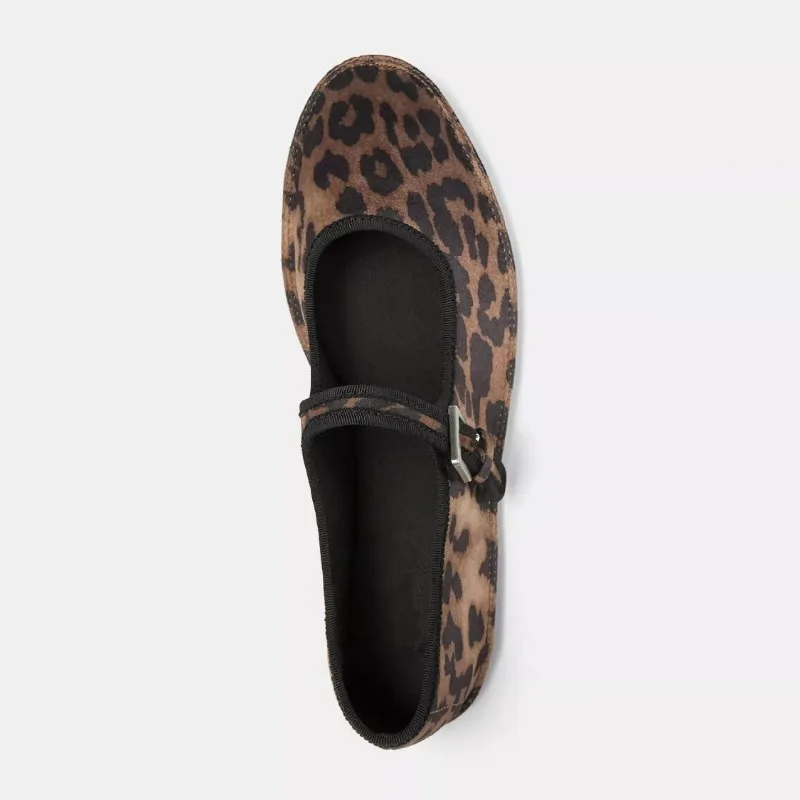
For those debating care requirements between popular options, our article on is suede or leather easier to care for helps clarify the maintenance differences.
9. Finding Your Perfect Match: Next Steps
After exploring the diverse world of loafer materials, you’re now equipped with the knowledge to make an informed decision that balances aesthetics, functionality, and your personal values. Remember that the perfect material choice depends on your specific lifestyle, usage patterns, and priorities.
When evaluating loafer materials during your shopping journey, consider this balanced approach:
- First, identify your primary use cases—formal work environments, casual weekends, or versatile day-to-night wear
- Next, assess your local climate and seasonal needs that might affect material performance
- Then, determine your maintenance commitment level and care routine preferences
- Finally, establish your budget with the understanding that quality materials often provide better long-term value
When examining potential purchases, take time to physically assess material quality. Look for even coloration, consistent texture, careful edge finishing, and attention to detail in construction. These quality markers transcend material type and indicate craftsmanship that enhances durability.
Remember that building a thoughtful loafer collection with different materials often serves you better than searching for one perfect pair. Different materials excel in different scenarios, and having appropriate options enhances both your style versatility and the longevity of each pair.
For those seeking a popular combination of elegance and practicality, our women’s suede penny loafers collection showcases timeless designs in premium materials that exemplify the principles discussed throughout this guide.

